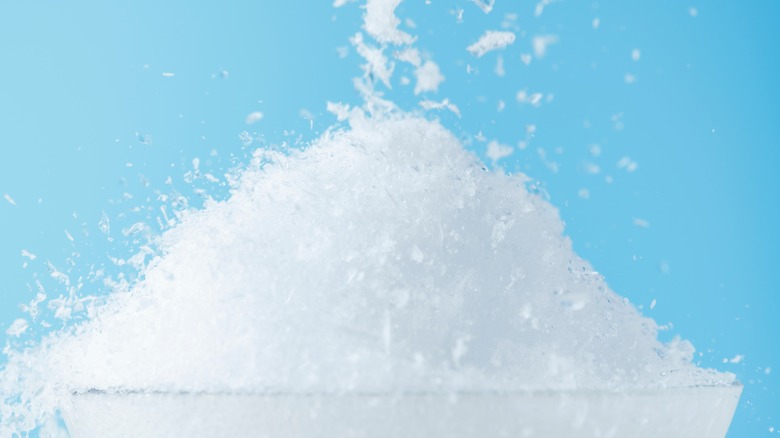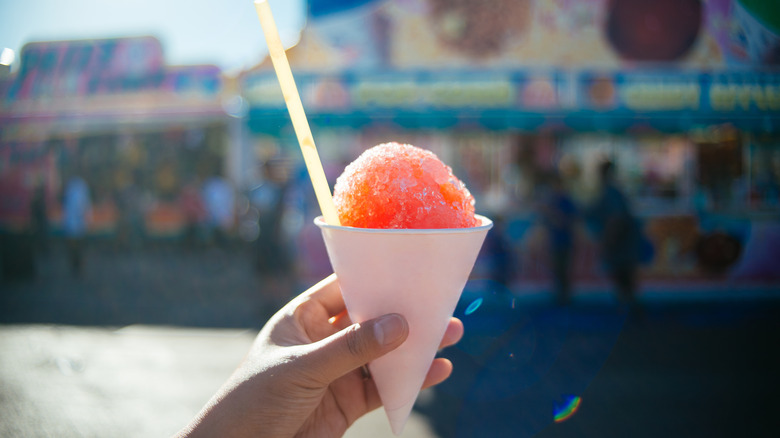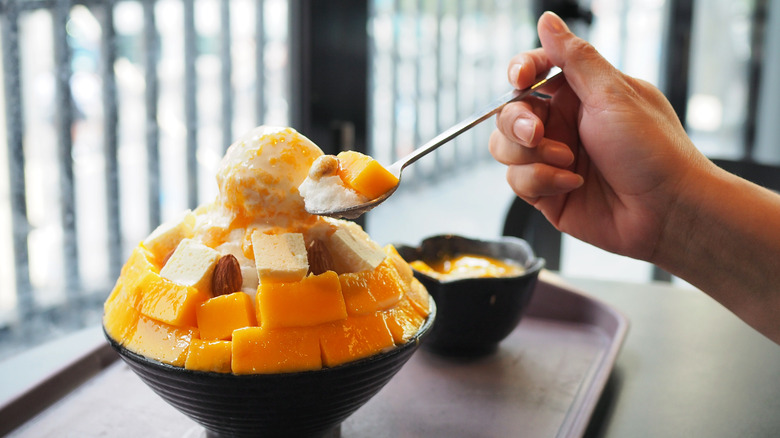The Texture Difference Between Shaved Ice And Snow Cones
We may receive a commission on purchases made from links.
When it comes to warm weather desserts, treats like shaved ice and snow cones are in a league all their own. They each hold a special place in the hearts of nostalgic adults and global gourmands alike. And while these two chilly treats share a key ingredient — ice — they each have their own distinct textures, which makes for surprisingly different eating experiences.
Snow cones, whether straight from the ice cream truck, concession stand, or made at home, are recognizably chunky and downright crunchy. They're made from crushed pieces of ice, giving them a heft that eaters have to really chew through. The frozen ingredient is then collected and shaped into a firm round before adding sweet syrups.
Shaved ice, on the other hand, is purposefully fluffy and melt-in-your-mouth soft. It's prepared using shavings — hence the name — that are scraped or whittled off from a larger block of ice. These pieces look similar to pencil shavings and are meant to capture the fleeting sensation of eating freshly fallen snow.
Of course, snow cones and shaved ice are not to be confused with Italian ice, which is made with a flavored base, rather than water.
Origins and textured toppings also differentiate the treats
Snow cones are a relatively straightforward snack. They're drenched in colorful and sweet syrups, then handed over to eager eaters. To personalize the treat, surprising combinations can be made by pairing bold commercial concentrates, like cola and blue raspberry flavors, or by preparing syrup at home with powdered soft drink mixes. The mechanically ground-up ice is about 100 years old. Samuel Bert, credited with inventing an ice scraping machine, debuted the technology in the 1920s.
In contrast, shaved ice has a much longer history around the world. The dessert dates back at least 1,000 years in China, where it's been called bao bing. Similarly in Japan, it stretches back to the Heian period (794-1185) where it's long been known as kakigōri. Although the smooth ice is a point of pride, aficionados will often experiment with multi-textured toppings that set the complex desserts apart from the fairground snow cone treat. Eaters can and will use zany syrups, like cotton candy and cake batter, but flavored ice is just the starting point.
Popular extras include creamy syrups, like sweetened condensed milk, as well as crunchy and chewy elements. This can include flaky coconut, mochi or rice cakes, and fresh fruit. Unlike the snow cone, shaved ice can also call for sundae-style treats complete with scoops of ice cream or sorbet. Purveyors of the cooling cups will also carefully stack the different components together, crafting towering and colorful sweets that are a visual indulgence, as well.
Shaved ice treats enjoyed around the world
To build your own version of these icy desserts at home or when in a dedicated shaved ice shop, there are a few beloved flavors to consider that can take flavor cues from long global traditions. In Hawaii, where "shave ice" has a loyal following, classic toppings overlap with those in Japan, since the dessert was brought over by Japanese immigrants. For a reminiscent taste, add azuki beans, a red bean paste that's used to sweeten the treats, as well as a salty-sweet powdered plum called li hing mui. Or, swap the fruit dusting for roasted soybean powder to mimic South Korean bingsu.
You can also channel South and Central American traditions for a shaved ice treat of a different name. In Mexico, enthusiasts call them raspados, whereas in El Salvador they are known as minutas. This iteration of the ice can skew slightly chunkier. That makes it a happy middle ground for snow cone fans; just use a blender to capture the light texture. To take inspiration from these bites, bright syrups made from fresh mango and chunks of pineapple are layered on. For added complexity, you can use chamoy sauce, spicy Tajín, nuts, and tart tamarind syrup.
Modern iterations of kakigōri, which has a growing stateside following in Los Angeles, balance savory and sweet flavors with ingredients like feta cheese and gorgonzola, corn, and fresh herbs. Favored bites also capture the taste of classics like Thai mango and sticky rice, banana pudding, and cheesecake.



